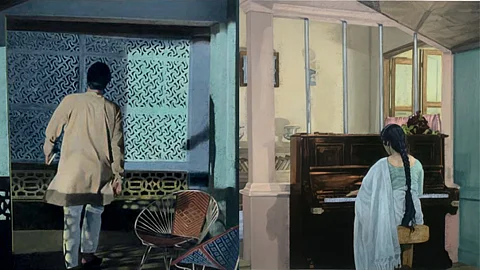
- HOMEGROWN WORLD
- #HGCREATORS
- #HGEXPLORE
- #HGVOICES
- #HGSHOP
- CAREERS
- ABOUT US
- CONTACT US

A lot goes into crafting each frame of a film; sometimes to a point where the cinematographer or director of photography even draws inspirations from compositions of paintings. If the frame is successful, with the right lighting, colour and production design, it comes out looking like a painting as well. Movies have a powerful world-building characteristic that make people remember its experience; both visual and visceral. Recreating that same experience, Atul Dodiya, a distinguished Indian artist, recently released his collection of paintings based on Hindi and Bengali films from the 60s and 70s.
There was a time in Atul's life when he was stood in front of two paths — having to choose between film and art. He chose the latter but couldn't quite shake his love for cinema which also reflected in his work like his fixation with the 1993 action thriller Baazigar’s poster, or a seven-minute sequence from Alfred Hitchcock’s Blackmail, or even using images from the films of Andrei Tarkovsky, Guru Dutt, Mani Kaul, and Ritwik Ghatak.
In an exhibition last month called 'Dr. Banerjee in Dr. Kulkarni’s Nursing Home and Other Paintings 2020-2022', Atul revisited the cinematic theme with a reel of 24 oil paintings capturing frozen moments from films such as Anand, Padosan, Mahanagar, Anupama, Awaara, Kaagaz Ke Phool, Ittefaq and Kapurush among others. 24 is a special number in cinematography, as there are 24 frames in each second. In this show, the 24 paintings mimicked a running storyboard, creating their own fiction.
I like watching films at home because I get a chance to pause a frame and look at it for as long as I want and sometimes screenshot it to admire it later. But a film theatre doesn't allow that; moving pictures go by fast. Atul was fascinated by the same photographic elements of these frames; of how when separated from the narrative, a frozen picture stood out; imbuing a mystery of its own. Consequently, Atul chose these moments or images from the films to engage with and to encourage their visual appeal.
Through this collection Atul invites the viewers to dive a little deeper into the films that we have already seen. The production design, with pastel hues of pinks, turquoise, and pale blues that in the film were just a device adding to the visual vocabulary of the story, now, when frozen, become their own worlds. In a frozen frame, we are allowed to notice a little more; the walls, the clothes, the physicality of the actor. Unlike in the film, we're not in a hurry to find out what happens next but are allowed to slowly simmer in the pictorial possibilities of each frame.
Follow Atul here.
